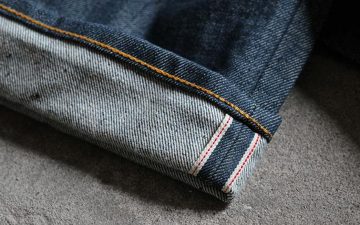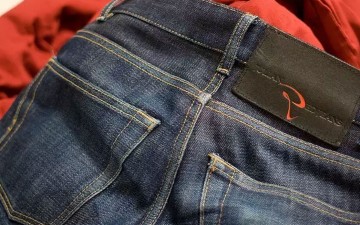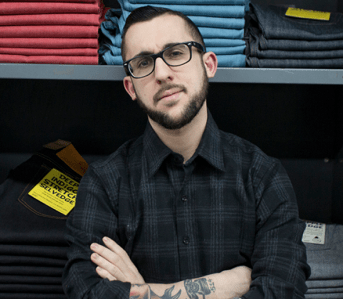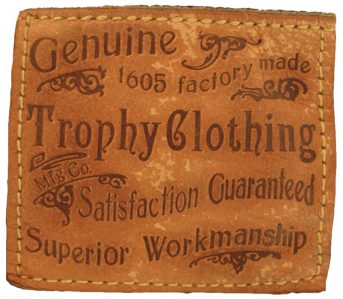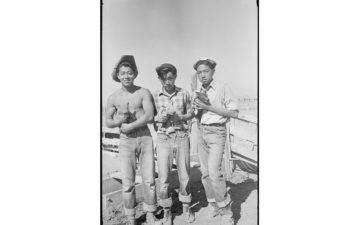When I first got into selvedge denim I would justify the exorbitant cost of my jeans to friends by talking about craftsmanship, vintage looms and clean edges. Sometimes I would even float the myth that the United States sold all of their shuttle looms to Japan in the wake of WWII and that’s why all the good jeans came from Japan before their eyes glazed over and I awkwardly shifted the topic of conversation.
Lately, though, I’ve found myself talking about different things when the subject of $200 or $300 jeans comes up. I talk about a return to American garment manufacturing. I talk about regionalism. I talk about denim made in the USA. Then I invariably end up making the connection between high-end jeans and craft beer. “It’s sort of like craft beer,” I often say. “You can buy jeans made by one person in New Jersery, or Nashville, or Virginia.” While the metaphor holds true in the sense of regionalism, it falls apart because, let’s be honest, beer is a renewable resource. We don’t go out every weekend, buy 10 to 12 new pairs of denim, eat something greasy, come home and order something we don’t need from Amazon before passing out on the couch.
We buy one pair of quality denim. We wear them (without washing, much to the chagrin of our friends and significant others) for a few years before we buy another pair. Sure, some people have a couple jeans in rotation, but high-end denim isn’t a product we’re buying all the time and it’s not a cheap product to make. This got me wondering–now that everyone and their cousin seems to have their own one man denim line, are one man brands sustainable?
To be perfectly honest, I don’t know. I think there’s space in the market for someone doing something right. I think there’s space for someone making a high quality product that appeals to denim nerds. I also think that there are far, far too many people dropping $6,000 on 43200G‘s and trying to distinguish themselves by exposing selvedge on the coin pocket or stitching some goofy nonsense on the pockets.
Since I felt totally unequipped to answer this question, I went to the one guy who probably has more experience selling and evaluating high-end denim than anyone else: Self Edge founder Kiya Babzani.
We all know that Babzani only carries the best of the best in his shop: Iron Heart, The Flat Head, Mister Freedom and 3sixteen among others. He knows his stuff and he’s probably seen more fledgling denim brands than you or I. And yet, he’s only chosen to carry a single one man brand in the shop’s San Francisco, LA, Portland and New York outposts. That brand, when he can keep them from flying off the shelves, is Roy Denim, made from start to finish by Roy Slaper in Oakland, CA.
Since Roy is the only one man brand to earn the Self Edge stamp of approval, a lot of our conversation was filtered through what Slaper does differently and, most importantly, right compared to some of the other upstart one man brands.
“I’ve seen all these jeans, I’ve seen nearly every single one of them travelling to the different Self Edge locations,” Babzani said. “And nobody does it like Roy. That has nothing to do with me selling the product, it was like he’d been waiting his whole life to do this.”

Roy Slaper (source: Vinyl Scratch)
Babzani said that what distinguishes Roy from a lot of start ups is his utter devotion to the craft of making jeans. Slaper spent two years just making jeans and giving them away to friends, the barista down the street, the line cook at a diner, literally anyone who would take them; before working on a product for a proper release.
In Babzani’s opinion, young denim makers would do well to follow this model.
The problem is that people want to make jeans and sell them right away. They should spend at least two years making seven pairs of jeans a day and throw them away, or give them away.
I assumed that Babzani would be concerned about the glut of new denim makers because it would dilute the market and potentially woo away customers. It’s just the opposite. “At first we thought this kind of sucks. Now we think this is a good thing. The more people making jeans will mean that Roy isn’t being judged as a one man operation. He’s literally being judged against everything now. If you pair everything together and take out the elements of the one man thing it levels the field,” he said.
Babzani feels that Slaper’s jeans can now be compared to Iron Heart, Sugar Cane and The Flat Head without the burden of being tagged as the label made by one guy. He agrees that one man brands should focus on making a quality product instead of trying to set themselves apart with aesthetic alterations.
“What customers actually want is a completely blank jean. The design elements that set you apart shouldn’t be noticeable after looking at a jean in one minute.” He said that Roy’s jeans perfectly exemplify this philosophy. “You’ve got the most insane details that are almost all hidden. I wrote on the Self Edge site that Roy’s jeans on the outside are built like a truck and inside built like a peacock.” Babzani believes this so firmly that he hangs Roy’s jeans inside out at the store.
It might still be too early to say what one man brands are going to make it and what brands are going to fold. If Babzani is to be believed, the brands that devote themselves to the craft and make a high quality product with attention to subtle detail will probably succeed.
Those that think wacky branding, a simple story and more exposed selvedge are a golden ticket to retail outlets may face tougher times as this market matures. Have faith, though, young jean makers. If you do it right, there is a chance you too can join the ranks of Roy as one of the most coveted and respected (one man) brands around.
At Self Edge we don’t say no because we already have Roy. If I found another guy that does what Roy does, we’d say yes.

